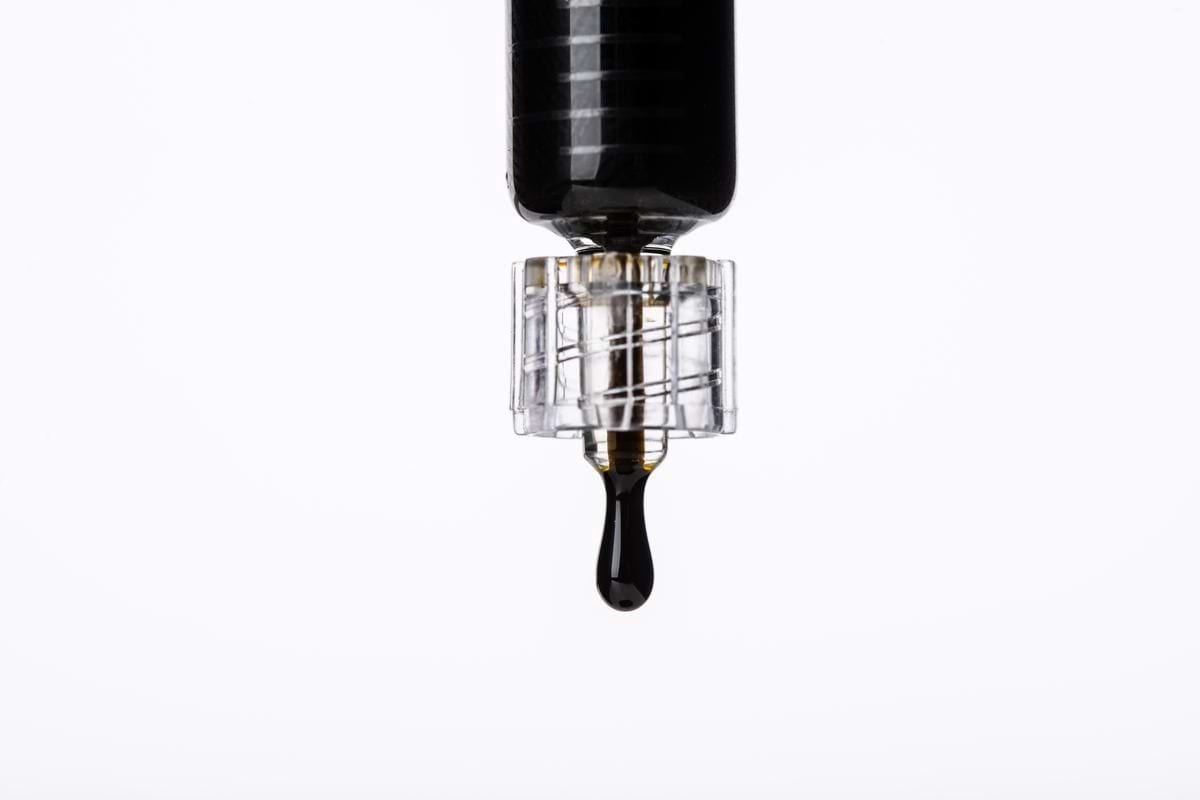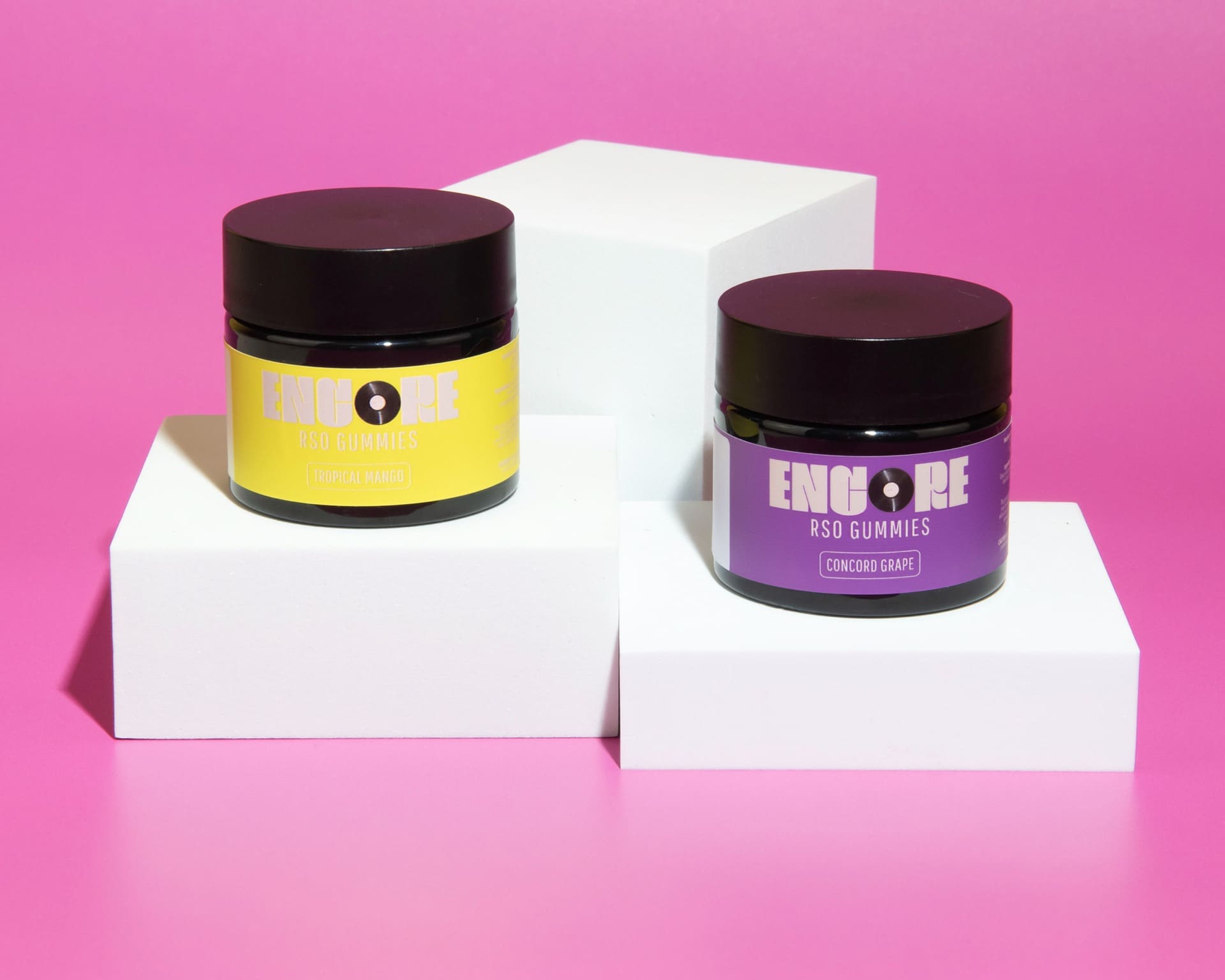At Ivy Hall Dispensary, we pride ourselves on being a welcoming pillar of knowledge for beginners and seasoned cannabis enthusiasts alike. At the same time, we believe it’s just as important to remain accessible and approachable. We won’t bombard you with niche jargon or lofty explanations but strive to promote a working understanding of cannabis and cannabis products so you can enhance your enjoyment. To help, we have created this series of “cannabis 101” blog posts designed to inform and inspire!
The ever-expanding selection of cannabis products and the countless variations promoted by the many brands on the market can easily become overwhelming, whether you’re new to cannabis or familiar with our favorite plant. One area that can seem particularly intimidating is the world of cannabis concentrates and extracts, especially since many of these products are comparatively new. Today, we would like to explore a unique concentrate: Rick Simpson Oil, otherwise known as RSO.
Keep reading to learn more about RSO, its benefits, and what continues to attract people to RSO products.
What Is Rick Simpson Oil (RSO)?

Rick Simpson Oil, or RSO, is a type of concentrated cannabis oil known in the cannabis community for its unique extraction process, methods of consumption, high concentration of cannabis compounds, and its purported pain relief and other medicinal benefits. This raw oil concentrate is often described as syrup- or even tar-like, with a thick, highly viscous consistency and dark color. Unlike many other concentrates, RSO is derived from the whole cannabis plant, allowing cannabinoids, terpenes, and even chlorophyll to seep into the oil. The result is potentially the best-known characteristic of this product – the comprehensive melding of a wide range of benefits known as the entourage effect.
This cannabis extract was popularized by and named for Rick Simpson, a Canadian engineer, cannabis enthusiast, and medical marijuana activist who has long advocated for the medicinal relief provided by cannabis – specially RSO.
After a serious fall in the late 90s resulted in a traumatic brain injury that developed into Post Concussion Syndrome, Simpson decided to try medicinal marijuana. He was so satisfied with the plant’s relaxing and sleep-promoting effects, such a stark contrast to prescription medications he felt did nothing, that he decided to further experiment with cannabis. His resolve was strengthened when he was diagnosed with skin cancer and prolonged tinnitus in the early 2000s.
After much work at home, Simpson developed and perfected an extraction method to produce what is now referred to as RSO. Since he began treating his skin with the oil concentrate, he claims his lesions dissipated, eventually leading to a full recovery. He proceeded to share his extraction process so RSO could be made accessible to the public and everyone could benefit from this unique oil.
The Extraction Method: How RSO Differs From Other Concentrates
RSO has garnered significant attention in recent years, particularly for its alluring claims of therapeutic benefits, such as pain relief and other effects. This has made the extract a popular topic of interest within the world of cannabis– especially in the category of concentrates – among recreational and medical users alike; but this begs the question: how exactly is RSO different from other cannabis concentrates or extracts?
Creating the Full-Spectrum Extract
Concentrates and extracts are noted for their potency compared to cannabis flower, and the product category overall is also renowned for its numerous variations, each with its unique texture, taste, method of extraction, ways to consume, sensory effects, and more. However, RSO is especially coveted for its extreme potency and potential therapeutic qualities, even compared to other cannabis extracts. RSO owes its high cannabis compound content to the way it’s made from the cannabis plant, lending the concentrate an unrefined potency.
The extraction method utilizes a solvent, ethanol, which, when kept at room temperature, as it is in the RSO process, collects all present compounds. Unlike most extraction processes, which use only the cannabis buds, RSO extraction makes use of the entire cannabis plant. The plant matter is placed into a container along with the solvent, and the creator strains the solution from any plant material, and repeats the process once more. The strained liquid is then heated to remove all residual solvent. The resulting oil product is placed into syringes for easy handling.
Using the entire plant results in an oil that consists of cannabis compounds beyond THC. In addition, using room-temperature ethanol as a solvent is key to the preservation of these compounds. The result is a unique, full-spectrum cannabis concentrate oil.
The Composition of RSO
The unique extraction process of Rick Simpson Oil is not only ideal since it captures cannabinoids, terpenes, chlorophyll, and other plant compounds that are present in the cannabis plant, but it also has little negative impact on these active ingredients. In other words, these plant compounds were subject to minimal degradation during extraction. The end product is a natural and fully intact, “whole-plant” cannabis oil rich in terpenes, cannabinoids, and other compounds.
Since these compounds are preserved, RSO is especially potent. High THC content means RSO can be exceptionally psychoactive. Other cannabinoids like CBD and CBN may help contribute to the therapeutic benefits like relaxation and sleep mentioned later in this post. The fully-preserved terpene profile that gives a strain its unique flavor and sensory effects can be experienced more fully with RSO than other cannabis products.
In addition to the cannabinoids and terpenes found in most cannabis products, RSO also contains the cannabis plant’s fatty acids and lipids (e.g., waxes, oils), flavonoids, proteins, chlorophyll, and more. These compounds give RSO its consistency and may contribute to its well-rounded entourage effect. Often, RSO enthusiasts require only small amounts of concentrate due to its potency in even small quantities.
The Benefits of RSO
RSO is celebrated for its powerful sensory effects. It is known for creating a full-body state of relaxation, long-lasting effects, and the ability to minimize some people’s problems with inflammation. This concentrate may be a promising option for those searching for a cannabis product to relieve the uncomfortable symptoms of many different ailments.
For example, the creator of RSO claimed that it reduced the intensity of chronic pain more effectively than some other forms of medical marijuana, particularly for individuals with back pain and those with persistent or severe migraines. The oil has also been reported to help relieve the constant inflammation that can accompany arthritis and multiple sclerosis, in addition to helping reduce nausea and stimulate the appetite of persons undergoing chemotherapy.
The creator of RSO and other RSO enthusiasts also suggest that the topical use of the extract is successful in treating various forms of skin lesions. Others have also claimed RSO concentrate is potentially beneficial in soothing asthma symptoms and may even aid in diminishing the severity of some seizure disorders, such as epilepsy.
Is There Evidence of RSO’s Ability to Treat Cancer?
Due to the extremely limited nature of cannabis research in the United States, there is not yet much evidence to prove the claim that RSO can slow or reverse the progression of cancer and its effects or symptoms. Until further research is conducted, RSO is not medically recognized as a treatment for cancer despite individuals who report significant results. However, that does not mean it’s not worth mentioning the many ndividuals (including Rick Simpson himself) who assert the effectiveness of RSO in easing the uncomfortable, adverse effects of cancer and bringing relief to its numerous related symptoms.
It should also be noted that some comprehensive reviews of studies done on the results of cannabinoids on the body suggest the general conclusion that cannabis overall has the potential to have anti-tumor effects. Another study mentioned in the review also asserted that cannabis may be possibly helpful when paired alongside other cancer treatments. In addition, isolated cannabinoid compounds like THC and CBD have long been accepted for their ability to bring relief to chemotherapy patients who are managing chronic pain, nausea and vomiting, and poor appetite.
How To Use RSO

The multiple methods of consuming RSO allow users to experiment, slowly finding their personal preference based on the specific effect desired. It’s important to keep in mind that, regardless of which way you choose to consume RSO, this thick concentrate typically requires slight warming to manipulate easily but should not be handled using high heat. Heating RSO excessively can transform the extract’s consistency and chemical composition, which can diminish its effectiveness and may even yield an unpleasant taste and more unpleasant sensations.
Additionally, in its raw state, RSO has a very strong flavor that is earthy and sometimes bitter. While we enjoy the smells and tastes cannabis has to offer, some users may find this unpalatable or off-putting. Be mindful of this when determining which consumption options you find most appealing, considering how its functionality, simplicity, or taste may enhance your experience.
Consumption Methods
These are the most common methods used to consume RSO.
Gummies and Other Edibles

Ingesting RSO via the countless varieties of RSO gummies on the market is one of the most popular ways to consume this concentrate. It can also be used to create edibles at home using very small quantities, and boasts the advantage of being able to control dosage easily. Ingesting RSO with food has the added benefit of allowing the body to slowly absorb the active cannabinoids after digestion and metabolization, which also allows for longer-lasting effects compared to other methods of consumption.
Ivy Hall Dispensaries carry RSO Encore cannabis gummies. They come in several mouth-watering flavors and come in packs of 10 or 5. You can learn more about them here: Encore Edibles.
RSO Drinks
Similar to edibles, it is also possible to consume RSO orally while you enjoy a drink. This can be achieved by freezing individual doses of RSO and later adding them to the beverage of your choice just as you would ice. The oil itself can also be added to a hot toddy or tea and stirred.
Tinctures
A tincture is a mixture containing RSO that has been diluted so that dosing the extract is much more manageable due to the lower viscosity. Traditionally, tinctures use alcohol as the preferred dilution liquid, but more modern alternatives include carrier oils such as hemp seed or coconut oil. Tinctures are traditionally swirled in the mouth and held under the tongue for absorption into the bloodstream through the network of capillaries that reside there. This method can decrease the onset of RSO’s effects since you are bypassing the digestive system.
Capsules
RSO capsules is a convenient, discreet method of oral consumption that is preferable for many people. The capsule prevents users from experiencing the distinct taste and offers precise dosages.
Syringe or “Dablicator”

RSO often comes in syringe applicators for simple and precise dosing. While the syringe can apply a measured dose of RSO for any of the uses above, many people choose to consume it orally. Use the syringe to carefully place a controlled amount of RSO under the tongue before swallowing after a few moments, much as you would a tincture.
Although it can be hard to find, most Ivy Hall Dispensaries carry the Avexia RSO Syringe pictured above. Snag one while you can!
Topicals
You can also use the syringe to apply the extract topically in small, controllable amounts – either place the dose directly onto the afflicted area or put it on your finger first and then apply. Applying RSO topically is a unique way to reap the benefits without having to ingest the product. This approach also lets you target the specific areas of your body in need of relief, making it a great option for localized pain or inflammation, skin conditions, and more.
Rare or Never: Smoke, Vape or Dab
Generally, the fatty components of RSO, along with its thick and sticky qualities, make it a less than ideal concentrate to smoke or vape. There are some RSO varieties that can be inhaled, but it’s not advised to vape or dab RSOs that were extracted using a flammable solvent. In addition, its consistency would require a high amount of heat in order to produce smoke or vapor for inhalation. Unfortunately, heating RSO can alter its compounds, impacting its effects and potentially resulting in an undesirable cannabis experience.
Finding the Right RSO Dose
Finding the ideal amount of RSO to consume will depend on you, your tolerance and general reaction to cannabis products, the condition or ailment you may be trying to address or target, and even your body chemistry. It’s always advised to start cannabis concentrates at a low dosage and increase slowly (remember: “go low and slow”). With RSO specifically, be sure to keep in mind the concentrate’s high potency.
We recommend starting at the lowest possible dose the first time you try RSO before slowly increasing in small increments. If you don’t feel any benefits after about 90 minutes, proceed to take another dose of the same amount as the initial one. Typically, the smallest dose is around 5mg for most people, but some may be inclined to be cautious with 2 mg increments. You can think of these portions as a grain of rice or half a grain of rice.
Possible Side Effects
RSO’s often high concentrations of THC, which is a psychoactive cannabinoid, in RSO, have the potential to produce certain reactions in some individuals, particularly those who are sensitive to THC or another compound that may be unique to a specific strain. Taking a dose that is too much for a person’s body and tolerance level can also yield some adverse psychological effects. Examples include anxiety, depression, irritability, disorientation, and, in rare cases, visual hallucinations.
Other potential side effects may include dry mouth, increased heart rate, low blood pressure, bloodshot or inflamed eyes, dizziness, difficulty remembering, impaired motor skills and control over limbs, sluggish digestion of food, slower reaction time, and trouble sleeping. As with any potent cannabis product, it’s advised to be observant and mindful by starting with low dosages and increasing slowly; this helps to avoid any uncomfortable or unpleasant side effects that may impact your experience. Most of the time, any adverse symptoms will only last a few hours and don’t pose any significant health risks that are cause for concern.
Did You Know? There Are Different Types of RSO

Pure RSO in its natural form is rich in THC and concentrated to be potent, but not all RSO products will have the same level of THC concentration or the same ratio of THC to CBD. This means that some RSOs or cannabis products that incorporate RSO may be more psychoactive than others. It’s important to remember the chemical composition that’s present below the surface of each cannabis product. The specific ratios and included compounds influence the nuance of effects that may enhance your experience or the therapeutic qualities of the compound..
In addition to potency, there’s also the matter of cannabis type and how the plant’s unique qualities can impact the sensory effects of RSO, including how you may experience and enjoy them. More specifically, understanding the type of cannabis within an RSO product gives the user greater control over what type to use depending on the time of day, the activities you plan on doing, the desired experience, and more. The specific combination of terpenes extracted from the cannabis plant is the driving force of “strain-specific” effects, and it’s important to know what a cannabis strain may be known for and the sensations or states of mind it can produce.
Remember that each person is different, with their own unique body chemistry, biometrics, overall health, medical conditions, and more. These factors mean every individual can potentially respond differently to the psychoactive and non-psychoactive compounds in a specific cannabis strain or product. You should never expect what a certain type of RSO or another product may do for you to exactly match what others have reported.
With that in mind, join us as we explore the two overriding types of cannabis. The two main categories exactly of strains a product can er include indica and sativa. While modern cannabis strains are hybrids, those dominated by either indica or sativa tend to produce a “signature” experience across the majority of people.
RSO Indica
RSO has traditionally been made from indica-dominant strains of cannabis. Indica variant plants are known for their sedative, relaxing, and sleep-promoting qualities, especially in powerful strains. Indicas are also renowned for their tendency to produce a blissful state of full-body relaxation, making this type of cannabis strain ideal for RSO. This is especially true due to the fact that the extraction method for RSO preserves the plant’s full profile of cannabinoids and terpenes.
This category of strains can produce a significant sensation of relaxation and drowsiness. Still, there’s no worry that ingesting indica RSO will instantly put you to sleep, or that you won’t be able to enjoy the experience, bodily sensation and pain relief. Many people opt to use indicas during the daytime while enjoying a laid back hobby or physical activity that’s not overly demanding.
RSO Sativa Effects
Sativa-dominant cannabis strains are more often associated with daytime use. That’s because the sensations sativas are known to produce include energizing, invigorating, uplifted mood, and feeling inspired or creative. RSO products that include concentrate made from sativa strains of the cannabis plant may be an option for you if you’re seeking relief or relaxation without the risk of becoming “locked in” too early in the day, as indicas have the tendency to do.
Some cannabis users enjoy incorporating sativa-dominant RSO products into their workout routine, particularly as a step in their post-exercise recovery to help wind down and encourage relaxation without losing energy. Sativas usually have a higher ratio of THC to CBD, which gives the strains that characteristic “boost” in recreational users and medical patients that can bring a positive outlook and even a feeling of being more sociable. This stands in contrast to indicas, which commonly have a more balanced ratio of THC and CBD known to yield a lulling, peaceful sensory experience.
Are Sativa or Indica RSOs for You?
You may find that you have a strong preference between sativas and indicas or that you enjoy both forms of RSO. We’ve found that many people choose to keep both types on hand to use in different situations. Due to RSO’s potency, finding what works for you and determining how to get the most out of your cannabis product can be a bit more important than with other product types.
You’ll find that both RSO types can be utilized in a therapeutic capacity, have anti-inflammatory properties, and can potentially relieve symptoms of anxiety. However, if you’re primarily looking for relaxation and sedation, indica RSO may prove more beneficial. In addition, if high THC content could potentially contribute to your anxiety, lower-THC indicas may be for you. If you’re looking for uplifting, energizing effects that won’t make you sleepy, or for higher THC impact, sativa RSO may be preferable.
It’s Not Just About Feeling Good… We Want You Feel Your Best

Whether you’re new to the cannabis community here in Illinois or a seasoned cannabis connoisseur, the friendly staff at your neighborhood Ivy Hall dispensary can help you find the products that are best for your needs. Experience our boutique cannabis shop, interact with the terpene display, and check out the amazing array of products we have. We’ll be waiting to provide you with tips, recommendations, and information about RSO or any of our other products. Visit your neighborhood Ivy Hall Dispensary or reach out to us for answers to your top cannabis questions and to discuss what products may best fit your needs.
Resources:
1.PubMed Central (PMC) Article: National Center for Biotechnology Information. (2014). Cannabinoids in health and disease. PubMed Central. https://www.ncbi.nlm.nih.gov/pmc/articles/PMC4171598/
2.Frontiers in Pharmacology Article: Frontiers in Pharmacology. (2016). Potential therapeutic uses of cannabis on appetite regulation. Frontiers in Pharmacology, 7, 361. https://www.frontiersin.org/journals/pharmacology/articles/10.3389/fphar.2016.00361/full
3.American Society of Clinical Oncology. (2022). Cannabis and cannabinoids: Patient education about precision medicine and side effects. Journal of Oncology Practice. https://ascopubs.org/doi/10.1200/OP.22.00080
